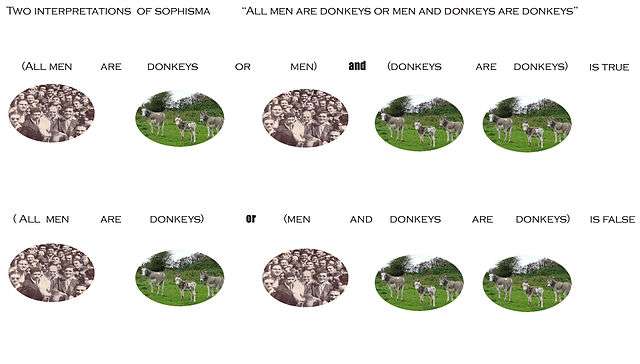Sophismata
Sophismata (from the Greek word σόφισμα, 'sophisma', which also gave rise to the related term "sophism") in medieval philosophy are difficult or puzzling sentences presenting difficulties of logical analysis that must be solved. Sophismata-literature grew in importance during the thirteenth and fourteenth centuries, and many important developments in philosophy (particularly in logic and natural philosophy) occurred as a result of investigation into their logical and semantic properties.
Sophismata are "ambiguous, puzzling or simply difficult sentences" that were used by Medieval logicians for educational purposes and for disputation about logic. Sophismata were written in Latin, and for many of them the meaning is lost, when they get translated to other languages. They can be divided into sentences that:[1]
- are odd or have odd consequences
- are ambiguous, and can be true or false according to the interpretation we give it, or
- have nothing special about them in itself, but become puzzling when they occur in definite contexts (or “cases”, casus).
When in the second half of the 19th century scholastic logic began to decline and be replaced by formal logic, discussions about sophismata and syncategoremata gradually became extinct[2] as the problem posed by them disappeared with the formalisation of the language. Thus, except the Liar paradox sophismata in general are trivially solved by modern analytical philosophy.
Example: All men are donkeys or men and donkeys are donkeys
All men are donkeys or men and donkeys are donkeys (Latin: Omnes homines sunt asini vel homines et asini sunt asini) is a sophisma that was first proposed and solved by the 14th century philosopher Albert of Saxony.[1][3][4] Albert of Saxony was a German philosopher known for his contributions to logic and physics, and his solution may have been influenced by the works of his fellow logician Jean Buridan.[5]
"All men are donkeys or men and donkeys are donkeys" is an example of the second class of sophismata; an ambiguous sentence that is open to more than one interpretation and could be either true or false depending on what interpretation is chosen.[1][3][6]
Solving the example
Solving the sophisma requires understanding the meaning of the sophisma sentence. In order to accomplish this three steps should be taken:
- Pro and contra arguments should be analyzed.
- A person, who proposed a sophisma, should present his or her own solution.
- A person, who proposed a sophisma, should prove his or her solution after he or she is presented with a different answer.[1]
In accordance with step 1, in order to prove that the sophisma "All men are donkeys or men and donkeys are donkeys" is true then it should be viewed as a logical conjunction's sentence that is a two-place logical operator "and". It results "true" if both of its operands are true, otherwise it represents "false". So in this case the sophisma could be interpreted as
("All men are donkeys or men") and ("donkeys are donkeys")
This presents "All men are donkeys or men" as the first logical operand and "donkeys are donkeys" as the second one. Both of the logical operands connected by "and" are true, and therefore the whole sentence is true. The first logical operand is a logical sentence on its own. It is a logical disjunction's sentence that is a two-place logical operator or. It results in a true sentence whenever one or more of its operands are true. "All men are donkeys or men" is true because while the first logical operand "All men are donkeys" is false, the second logical operand or "men" is true. Therefore, the whole logical disjunction indicates that the sentence is true. The second logical operand "donkeys are donkeys" is true because donkeys are donkeys.[1][6]
In accordance with step 1, in order to prove that the sophisma "All men are donkeys or men and donkeys are donkeys" is false then it should be looked at as a logical disjunctions sentence. In this case the sophisma could be interpreted as
("All men are donkeys") or ("men and donkeys are donkeys")
This presents "All men are donkeys" as the first logical operand and "men and donkeys are donkeys" as the second one. Both of the logical operands connected by "or" are false, and therefore the whole sentence is also false. The first logical operand is false because all men are not donkeys. The second logical operand "men and donkeys are donkeys" is a logical conjunction on its own and is also false. This is because although donkeys are donkeys men are not donkeys. Because it is connected by "and" this logical conjunction with one true logical operand and one false indicates that the sentence is false.[1]
In accordance with step 2, Albert of Saxony proposed his own solution of the sophisma that proved it could result in both being truth and being false depending on the interpretation of the ambiguous sentence.[1][3][6]
In accordance with step 3, Albert of Saxony did not have to prove this proposed solution because it covered both possible scenarios (being true and being false).[1][3]
References
- "Sophismata". Stanford Encyclopedia of Philosophy. September 30, 2001. Retrieved February 11, 2011.
- Gyula Klima (October 3, 2004). "Syncategoremata" (PDF). Fordham University. Retrieved February 11, 2011.
- Philotheus Boehner (April 16, 2010). Medieval Logic. Forgotten Books. p. 97. ISBN 978-1-4400-6696-2. Retrieved February 11, 2011.
- Paul of Venice, Alexander Broadie (June 1, 2000). Philosophy. Oxford University Press. p. 147. Retrieved February 11, 2011.CS1 maint: uses authors parameter (link)
- by Maarten J. F. M. Hoenen and Paul J. J. M. Bakker (June 1, 2000). Philosophie Und Theologie Des Ausgehenden Mittelalters: Marsilius Von Inghen Und Das Denken Seiner Zeit (German Edition). Brill Academic Publishers. p. 100. ISBN 978-90-04-10912-4. Retrieved February 11, 2011.CS1 maint: uses authors parameter (link)
- Roy A. Sorensen (December 4, 2003). A brief history of the paradox: philosophy and the labyrinths of the mind. Oxford University Press. p. 201. ISBN 978-0-19-515903-5. Retrieved February 11, 2011.
